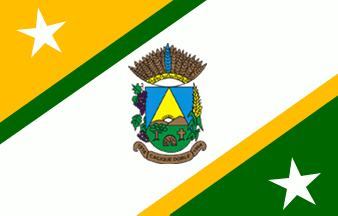 image by Dirk Schönberger,
10
January 2012
image by Dirk Schönberger,
10
January 2012Source: http://www.citybrazil.com.br/rs/caciquedoble/geral_detalhe.php?cat=9

Last modified: 2020-07-14 by ian macdonald
Keywords: rio grande do sul | cacique doble |
Links: FOTW homepage |
search |
disclaimer and copyright |
write us |
mirrors
 image by Dirk Schönberger,
10
January 2012
image by Dirk Schönberger,
10
January 2012
Source:
http://www.citybrazil.com.br/rs/caciquedoble/geral_detalhe.php?cat=9
The municipality of Cacique Doble (5,065 inhabitants in 2019; 20,380 ha) is
located 400 km north of Pörto Alegre.
Cacique Doble is named for Faustino
Ferreira Doble, a respected cacique. When aware that the two daughters of
tropeiro João Mariano Pimentel had been abducted by Indians, he commissioned a
patrol to retrieve them, which was done a few days later near Tapir River, in
the municipality of Antônio Prado.
https://www.caciquedoble.rs.gov.br/
Municipal website
Ivan Sache, 13 July 2020
Diagonally divided on a rising diagonal, yellow-white-green, with the yellow-white boundary bearing a narrow green border and the white-green boundary bearing a narrow yellow border, each triangular panel with a white five-pointed star, slightly tilted, and the municipal arms in the centre.
Official website is at
http://www.caciquedoblers.com.br
Dirk Schönberger,
10 January 2012
The flag and arms of Cacique Doble were modified by Municipal Law No. 20
promulgated on 18 May 1989.
Article 2.
The flag features elements
representing origins, past and history; Its colors have the following meaning;
§1. Yellow: The original resources of the people, its works of European
culture, united to its forests with typical araucarias, interconnects yellow and
green.
§2. White: This stripe has the biggest expansion, spreading in a
spontaneous and communicative manner the highest liberty. [...]
§3. Green:
Interconnected with yellow, resources and forests. Green represents natural
resources in a bigger quantity to push nature preservation and ecological
cultivation.
§4. Stars: The stars represent the districts. The bigger star
represents the main center of power, the seat of the district. The smaller star
represents the secondary center of power, located in the 2nd district, São Luis
Rei.
Article 3.
The coat of arms contains the following elements:
§1. Topography: Rugged, characteristic of the soil physic.
§2. Sun: Real
picture of a magnificent sunrise. always present, embellishing the Earth since
the origin.
§3. Tree: Araucaria angustifolia. Cacique Doble is
included in the araucaria world's epicenter.
§4. Cross: Symbol of indigenous
evangelism and of the faith of a people living this way.
§5. Oca [typical
Brazilian indigenous hut]: First dwellings.
§6. Pyramid: Symbol of positive
energy. Connects to the sunset until it gets lost in the infinite blue. Force
that is renewed every day after the historical rescue.
§7. Supporters:
Grapes, wheat and maize, the predominant crops.
§8. Shield's upper part. The
war bonnet fully characterizes the origins. Symbol of citizenship. A chief's
protecting armor and the essence of his rule. A community way of good living
§9. Red scroll: 1916 - District's establishment. 1964 - Emancipation.
https://leismunicipais.com.br/a/rs/c/cacique-doble/lei-ordinaria/1989/2/20/lei-ordinaria-n-20-1989-modifica-a-bandeira-o-brasao-e-cria-o-hino-do-municipio
Leis Municipais database
Araucaria angustifolia (Bertol.)
Kuntze, aka Brazilian pine, was subsequently proclaimed the municipal plant by
Municipal Law No. 995 promulgated on 25 August 2008. Endemic to southern Brazil
and neighboring areas in Argentina and Paraguay, the Brazilian pine is listed as
"critically endangered" on the IUCN Red List of Endangered Species 2013.
https://leismunicipais.com.br/a1/rs/c/cacique-doble/lei-ordinaria/2008/100/995/lei-ordinaria-n-995-2008-define-ave-flor-e-planta-simbolos-do-municipio-e-da-outras-providencias
Leis Municipais database
Photos
https://www.caciquedoble.rs.gov.br/pg.php?area=NOTICIASVER&id_noticia=323
Ivan Sache, 13 July 2020